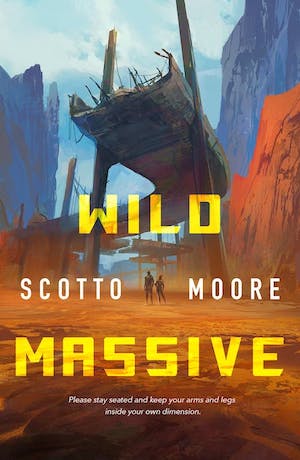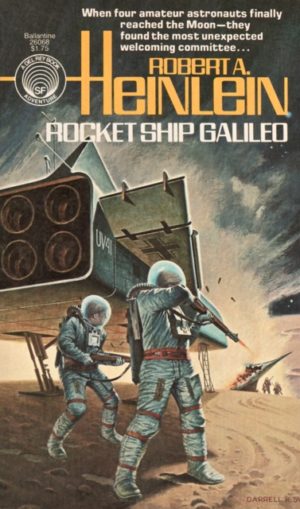In this bi-weekly series reviewing classic science fiction and fantasy books, Alan Brown looks at the front lines and frontiers of the field; books about soldiers and spacers, scientists and engineers, explorers and adventurers. Stories full of what Shakespeare used to refer to as “alarums and excursions”: battles, chases, clashes, and the stuff of excitement.
After World War II was over, Robert A. Heinlein decided to dip his toe into a new market—that of juvenile fiction, in the form of science fiction novels targeted mainly at young boys. This type of adventure had been around for many decades, but Heinlein decided the stories could benefit from the same kind of rigor and scientific accuracy that he and his fellow authors brought to the pages of Astounding. The first book in this series, Rocket Ship Galileo, was an interesting take on the old familiar “boys help a lone scientist” plot of the older tales, which Heinlein wedded to a more realistic approach to the scientific aspects of the story.
I’ve been reading or rereading all of Heinlein’s juveniles during recent years, and am of the opinion that they represent some of his best work. I’ve reviewed three of Heinlein’s juveniles already in this column, and over the coming months, I plan to periodically revisit them until I’ve looked at the whole series.
Rocket Ship Galileo is one of the Heinlein juveniles I had missed in my youth. I skipped it because the premise, a trio of teenagers helping a scientist build an atomic rocket, seemed a bit far-fetched to me—too much like the lurid boy science adventures I had read in my youth, which were almost entirely fantasy wrapped in the most preposterous science possible, books like the Stratemeyer Syndicate’s Great Marvel Series. But last year, I found an audio CD of Rocket Ship Galileo for sale, read by one of my two favorite book narrators, Spider Robinson (the other being Neil Gaiman, but that’s not important right now). As I enjoy listening to audiobooks while building models, I decided it was time for a listen.
I am not the first person from Tor.com to discuss this book, as the inimitable Jo Walton reviewed it a decade ago (her review is here). Elements from Rocket Ship Galileo also inspired the script of the 1950 movie Destination Moon, where Heinlein was credited as one of the scriptwriters (and you can read a review of his novella treatment of Destination Moon here).
About the Author
Robert A. Heinlein (1907-1988) was one of America’s most widely known science fiction authors, frequently referred to as the Dean of Science Fiction. I have often reviewed his work in this column, including Starship Troopers, The Moon is a Harsh Mistress, “Destination Moon” (contained in the collection Three Times Infinity), The Pursuit of the Pankera/The Number of the Beast, and Glory Road. From 1947 to 1958, he also wrote a series of a dozen juvenile novels for Charles Scribner’s Sons, a firm interested in publishing science fiction novels targeted at young boys. These novels include a wide variety of tales, and contain some of Heinlein’s best work (the books I’ve already reviewed in this column are underlined, with links to the article): Rocket Ship Galileo, Space Cadet, Red Planet, Farmer in the Sky, Between Planets, The Rolling Stones, Starman Jones, The Star Beast, Tunnel in the Sky, Time for the Stars, Citizen of the Galaxy, and Have Spacesuit—Will Travel.
Heinlein’s Rocket and My Family’s Nuclear Secret
I’d always known my father was an aerospace engineer who worked in research. But a few years before he died, he told me the specific projects he had worked on involved nuclear power plants. Since the early days of nuclear power, the main application of nuclear power has been to use uranium-fueled reactors to heat water that drive steam turbines, a technology used in nuclear ships, submarines, and shore-based powerplants. My father’s group, though, was looking at more exotic applications. There were ideas for nuclear power plants on spaceships and aircraft, but because of emerging research on the effect of radiation on humans, and the weight of shielding required, these ideas did not prove feasible.
When my father was employed, he was not at liberty to discuss the nature of his job (and he didn’t tell me much even when he did finally talk). In retrospect, however, I should have been able to guess more about what he was doing. Among his shelves of science books there was a whole shelf devoted to nuclear science, including a number of books on the Manhattan Project, which kindled my own interest in nuclear issues.
Buy the Book


Wild Massive
The type of power plant used in Rocket Ship Galileo, which would heat reaction mass to the point where it could push a spaceship into orbit, would have had to be far more efficient than nuclear power plants in common use today. Heinlein’s approach was to use the radioactive element thorium in a fission reactor, heating zinc to a gaseous state as a reaction mass, an approach called a nuclear thermal rocket. While (with various reactors and reaction mass) this propulsion method was used on test stands from the 1950s through the 1970s, it has never been used in flight. In theory, nuclear rockets can be more efficient than chemical rockets, but in practice the need for shielding and the threats of radioactivity made the method unattractive. Heinlein’s proposal to use zinc, a heavier element than hydrogen or water, as a reaction mass would give the rocket more power. But while zinc has a boiling point of 1665 degrees F, well within the range of chemical rocket exhaust temperatures, zinc is a solid below its melting point of 788 degrees F, which poses all sorts of technical challenges for fuel storage that (outside of a fictional story) can’t just be waved away.
Because nuclear thermal rockets do not lend themselves to fine control, Heinlein describes the use of aniline and nitric chemical rockets for maneuvering and landing. The ship does not perch on its tail like the V-2 rockets that inspired so many science fiction stories and illustrations in the post-war era, but instead is designed to land on its belly.
My father is no longer with us, and I found myself wishing I had read this story before his death so we could have discussed the science behind it. I am sure he would have had a lot of ideas and insights, and probably would have ended up reaching for paper along with his favorite multicolored mechanical pencil to do some sketching and graphs to illustrate his points.
Rocket Ship Galileo
Three boys—Ross Jenkins, Art Mueller, and Morrie Abrams—are gathered behind a berm near an amateur rocket test stand. They call themselves the Galileo Club, and this is no ordinary model rocket they are testing. They push it to its limits and it blows up, spraying the area with debris. Nearby, they find a man unconscious with a head wound: Doctor Donald Cargraves, a nuclear engineer and veteran of the Manhattan project, who also happens to be Art’s uncle. They take him to a hospital, and after he is patched up, he asks to see their clubhouse. Impressed by the boys’ use of the scientific method and their math and engineering expertise, Cargraves asks them if they would help him go to the moon. He recently quit his position with a nuclear energy corporation to pursue this dream, which large corporations and the government have decided is too costly. But he has developed a nuclear reactor that could fit in a converted sub-orbital cargo rocket, and thinks that with a few assistants, he could meet the challenge.
As the three boys have just graduated from high school, however, the first challenge is to gain permission from their parents. Cargraves first approaches his sister, Art’s mother. She is a single mother, her husband having died as a result of mistreatment in a concentration camp during World War II. She is frightened, but grudgingly gives her consent. Then Morrie approaches his father. Mr. Abrams has already given Morrie permission to go to technical school instead of joining the family business, and advises against the idea. But he also tells Morrie that he has been an adult since his bar mitzvah, and the decision is his own.
Cargraves then goes to Mr. Jenkins, a successful and wealthy engineer, who offers to partner with Cargraves and hire three engineers instead of the boys. He wants his son to get his engineering degree before he does anything else, especially something as risky as working on an experimental rocket. But eventually Mrs. Jenkins intervenes, and says it is okay for Ross to go, and it becomes apparent that Mr. Jenkins was arguing on behalf of his wife, who initially did not want to sign off on their son’s plans (this is surprising, as most of the wives in Heinlein’s juveniles, no matter how competent, are irritatingly subservient to their husbands).
The team then moves to a secluded outbuilding in the center of a former military artillery range, much of it still not swept for unexploded ordnance, located near the site of a UN military nuclear test site (I would have liked to hear more about how a nuclear-capable UN military would work, but Heinlein apparently decided that was not important to the story). Cargraves and Morrie, who both have pilot licenses, fly in the obsolete sub-orbital cargo rocket they have purchased (crewed rockets are being replaced by automated vessels). This section of the book is rich in details on how spacesuits work, details on nuclear power and radiation threats, information on dosimeters to monitor personal exposure, and other specifics related to the construction and equipping of the craft, which they dub Galileo, after the name of their club.
There are strange incidents and signs of snooping, so they set up alarms and purchase two Army surplus Garand rifles and a revolver to protect themselves. There is a visit from a Civil Aeronautics Board inspector, and then an explosion (the alleged CAB inspector was not who he claimed to be). Cargraves is knocked unconscious, and Ross is temporarily blinded. While Cargraves is out, the boys sign for the thorium that will fuel the reactor, something Cargraves had arranged to receive as a researcher. He is insistent their endeavor is over, as he doesn’t want to risk the boys’ safety any further. But the boys declare him not competent to make decisions until he can recover from his injuries, and by the time he does, he is ready to move ahead again. Cargraves suspects that the injury he received when he first visited the boys was not due to shrapnel from their rocket experiment, but someone attacking him from behind. From this point forward, the local authorities are alerted to possible threats, and the boys establish a continuous armed watch.
The explosion, as it turns out, did not damage any vital systems, at least not beyond repair, and the project moves forward, giving Cargraves plenty of opportunities to explain rocket construction techniques to his eager assistants (and to the readers, of course). And before long, they have taken off for the moon. The trip is relatively uneventful, but offers Cargraves a chance to helpfully describe the ins and outs of rocket navigation and orbital mechanics.
Once Galileo reaches the moon, after a fairly accurate description of the conditions that would be found on the Apollo missions, the boys construct a Quonset hut-type portable building to use as a base while they explore. It is a good thing they have the shelter, because at that point, Heinlein decides to put the science aside to make the proceedings as exciting as possible. Our protagonists have a cryptic radio conversation with someone also on the moon, and soon a small rocket hopper flies overhead and drops bombs that destroy Galileo. It turns out there are unrepentant Nazis on the moon, with nuclear weapons they intend to use to conquer the Earth (I would have put a spoiler alert on that, had it not been shown on the cover and teased on the flyleaf). The Nazi base is built within the ruins of an alien structure, indicating that the moon was inhabited at one time. The only way to return home is to attack that base and capture the Nazi’s own rocket.
In his juveniles, Heinlein never shied away from putting his young protagonists in some grim situations, and this book is no exception. Soon they are trading shots with Nazis, and as they learn more about the Nazi plot, their possession of nuclear weapons, and discover that their rocket was built in Detroit, it becomes clear that Nazi sympathizers are deeply embedded in society back on Earth (solving that problem is something I would have enjoyed reading more about, but Heinlein again decided that wasn’t important right now). And the book, which started out with a pretty workmanlike description of engineering challenges, ends with some highly lurid action that would have been right at home in the old pulps.
Final Thoughts
Rocket Ship Galileo was far more plausible than the juvenile science fiction that preceded it, although the premise of a lone scientist and a group of boys launching successful space missions still stretched credulity. Heinlein packed a lot of scientific detail into the story, and it seems clear he was trying to inspire a new generation of scientists and engineers. While this isn’t the strongest of his juvenile novels, it is certainly a solid first step.
I’m sure more than a few of you have read Rocket Ship Galileo, or other works by Heinlein, and have your own thoughts to share. I look forward to hearing them, but do ask you to keep the discussion focused on the books and how they fit into the large scope of science fiction and adventure stories (Heinlein-related threads seem to get off-topic rather easily!).
Alan Brown has been a science fiction fan for over five decades, especially fiction that deals with science, military matters, exploration and adventure.










